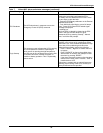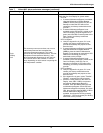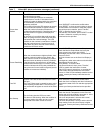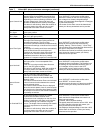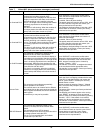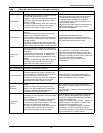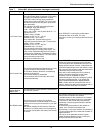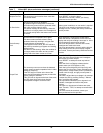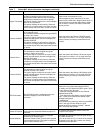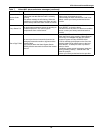
UPS Alarm and Status Messages
58
Manual Xfer Inhibit
This summary event means the conditions
required to perform a manual transfer to bypass
are not met (Inverter must be in sync with
bypass).
This status message is self-clearing. When the
condition is no longer present, the message and
any control activity tied to the status event reverts
to normal
The condition clears from the Active Event Window
when manual transfers are enabled.
A possible reason for this condition is an unstable
generator. If the generator frequency is not stable,
or not at 60 Hz, the Inverter may have difficulty
maintaining synchronization with the bypass
source.
To check the synchronization of the Inverter to
bypass, click “Transfer” and observe the
synchroscope. A non-sync condition is indicated by
a varying phase angle error, rather than a stable “0”
degree indication.
If the unit is not on generator, and the bypass
voltage otherwise appears normal, contact your
factory-authorized service provider.
Max Load Alarm
Ph A
The user adjustable maximum load alarm
threshold was exceeded. This is a “notification
only” type alarm, meaning the UPS takes no
action other than sounding an audible alarm
based on this setpoint. The setting allows the user
to monitor the load status of the UPS.
For example, if the current load on Phase A is
50%, the user can set this setpoint to 80% and an
alarm is received if the added load exceeds 80%.
The alarm may also be configured with a delay, to
prevent nuisance alarms due to cycling loads.
The alarm is self-clearing. Once the load level
decreases to less than 95% of the level setting,
the alarm clears.
Press “SILENCE” to silence the audible alarm.
Check the kW load % displayed for A phase.
To check the setpoint for the alarm, press “Config,”
“User Settings,” “Adjustable Setpoints,” “Max Load
Alarm.”
Compare the setpoint to the displayed load
percentage. If the load percentage displayed is
correct and the value exceeds the setpoint, raise
the setpoint to clear the alarm, or reduce the load
below the setpoint.
Contact your factory-authorized service provider.
Max Load
Alarm Ph B
The user adjustable maximum load alarm
threshold was exceeded. This is a “notification
only” type alarm, meaning the UPS takes no
action other than sounding an audible alarm
based on this setpoint. The setting allows the user
to monitor the load status of the UPS.
For example, if the current load on Phase B is
50%, the user can set this setpoint to 80% and an
alarm is received if the added load exceeds 80%.
The alarm may also be configured with a delay, to
prevent nuisance alarms due to cycling loads.
The alarm is self-clearing. Once the load level
decreases to less than 95% of the level setting,
the alarm clears.
Press “SILENCE” to silence the audible alarm.
Check the kW load % displayed for B phase.
To check the setpoint for the alarm, press “Config,”
“User Settings,” “Adjustable Setpoints,” “Max Load
Alarm.”
Compare the setpoint to the displayed load
percentage. If the load percentage displayed is
correct and the value exceeds the setpoint, raise
the setpoint to clear the alarm, or reduce the load
below the setpoint.
Contact your factory-authorized service provider.
Max Load
Alarm Ph C
The user adjustable maximum load alarm
threshold was exceeded. This is a “notification
only” type alarm, meaning the UPS takes no
action other than sounding an audible alarm
based on this setpoint. The setting allows the user
to monitor the load status of the UPS.
For example, if the current load on Phase C is
50%, the user can set this setpoint to 80% and an
alarm is received if the added load exceeds 80%.
The alarm may also be configured with a delay, to
prevent nuisance alarms due to cycling loads.
The alarm is self-clearing. Once the load level
decreases to less than 95% of the level setting,
the alarm clears.
Press “SILENCE” to silence the audible alarm.
Check the kW load % displayed for C phase.
To check the setpoint for the alarm, press “Config,”
“User Settings,” “Adjustable Setpoints,” “Max Load
Alarm.”
Compare the setpoint to the displayed load
percentage. If the load percentage displayed is
correct and the value exceeds the setpoint, raise
the setpoint to clear the alarm, or reduce the load
below the setpoint.
Contact your factory-authorized service provider.
MBD Open
The Module battery disconnect is open.
This alarm is self-clearing. When the condition is
no longer present, the alarm and any control
activity tied to the alarm reverts to normal.
Press “SILENCE” to silence the audible alarm.
Check the status of Module Battery Disconnect
(MBD). If it is open, the alarm is normal.
If the Module Battery Disconnect is closed, contact
your factory-authorized service provider.
Table 7 Liebert NXL alarm and status messages (continued)
Event Message Event Definition Recommended Action



